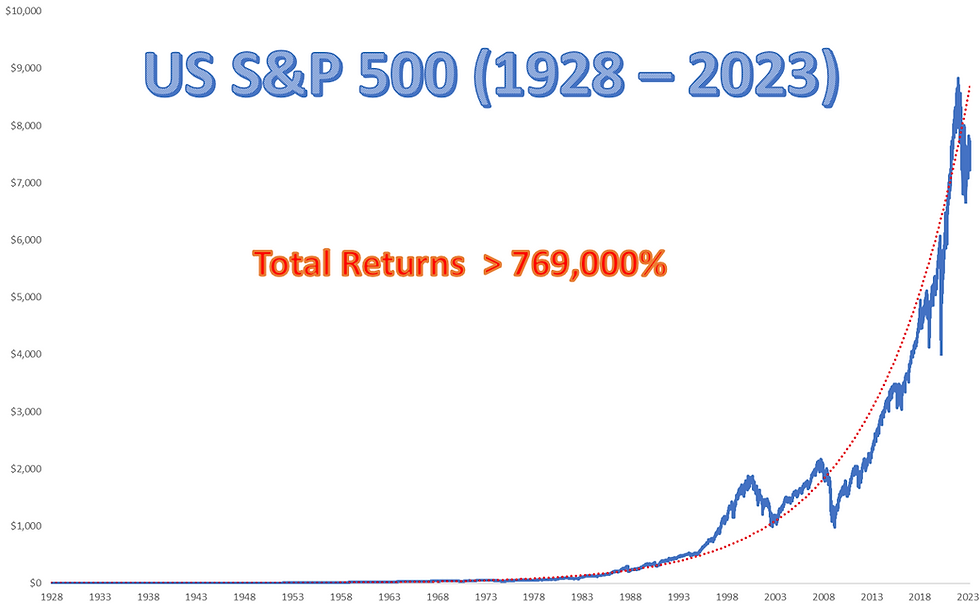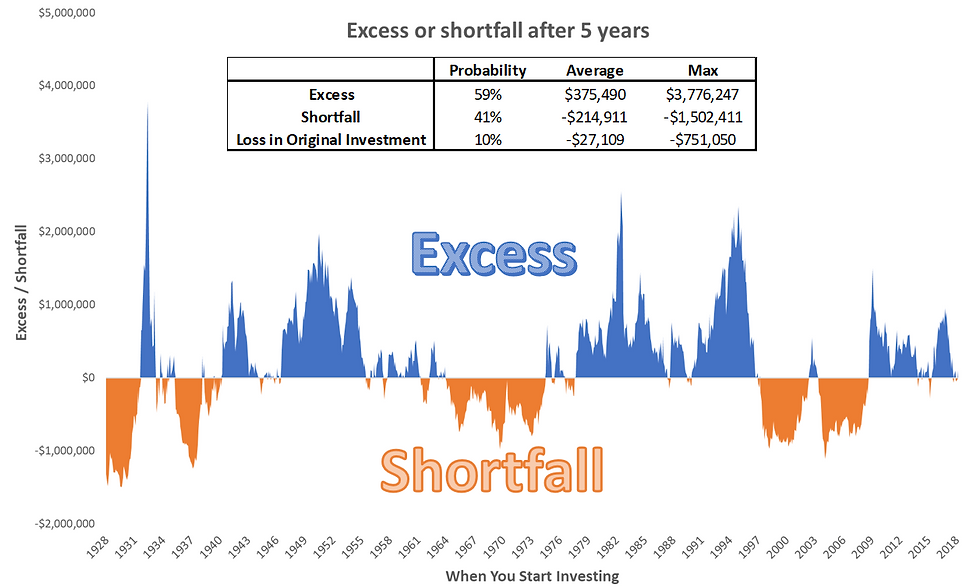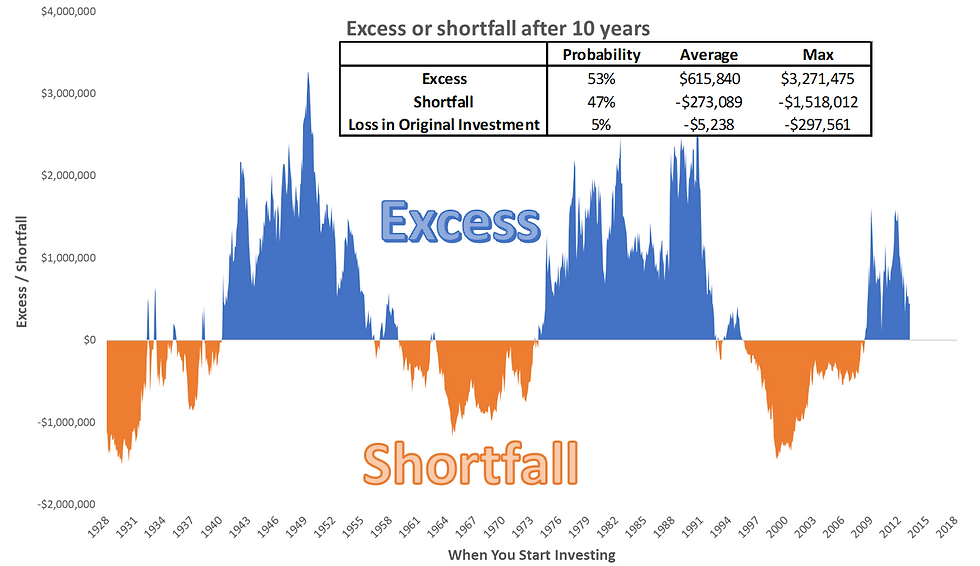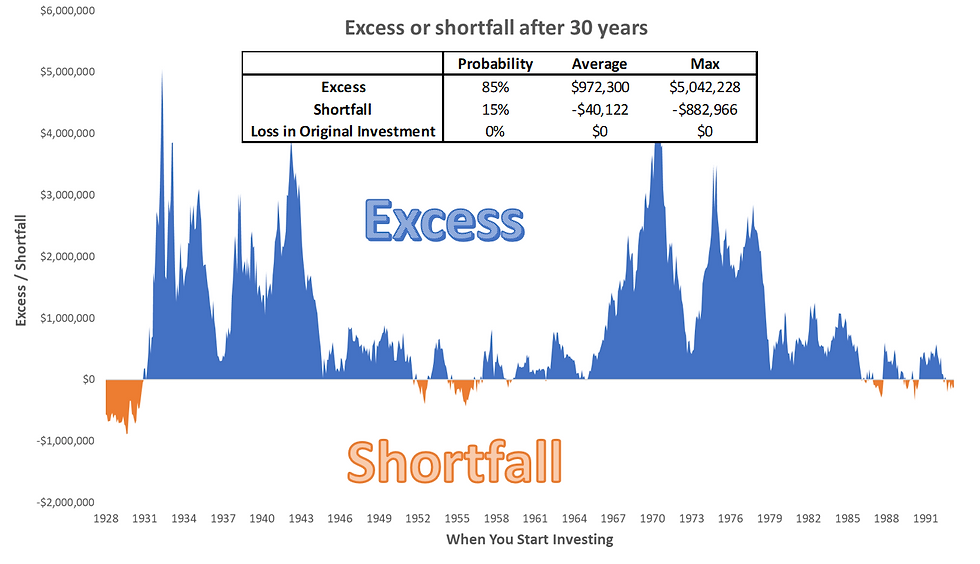Investing In The Stock Market - How Long Is Long Term?
- Eng Guan
- Apr 12, 2023
- 7 min read
Do you invest? And if you do, how do you go about making money from the financial markets? This is a very fundamental question. But do not be surprised if most investors are not able to give you a clear answer even on the broad principles or philosophies they follow. Because many are casual investors. They simply pump what they have into the stock market. This is fine until they start reacting to the market's ups and downs according to their emotions or whims. And that is where you get people who end up selling bottoms and buying tops only to lose money in the long run and give up. Now, if you don't have a plan, then statistically, it is better to just buy a diversified basket of stocks and hold it for the long term. The time you stay invested has a material impact on your chance of success.
Let's go through the historical evidence.
How Have The US Stock Market Performed Since 1928
The history of stocks has been well studied and most of these centered around the US stock market which is the largest and most established financial market with the longest history. And yes, the evidence does support the thesis behind investing in stocks over the long term. There is no doubt about this. The chart below shows you the growth of the US S&P 500 index which gives a good proxy for the overall performance of the broader US stock market. Since 1927, the US stock market grew nearly 769,000%*. This assumes you reinvest the dividends back into the market. Given such results, it is no surprise this particular chart is often highlighted whenever someone makes a case for stocks.

Will An Investment In The Stock Market Meet Our Needs?
While such a picture can easily whet someone's appetite, we should not just jump in on that. We also need to consider things in light of our circumstances and what is practical for us. To do that, we need to look at a few things.
What is your desired outcome?
Most people just quote a number off their heads without really thinking this through. If you are looking at retirement planning, then your desired outcome will depend on the amount you need at the point at which you retire taking into account things like inflation, your lifestyle, your needs, how much time you have till then, the expected return of your investments, and how much you can spare to invest.
What is your investment horizon?
As much as we like what is shown in the earlier chart, we don't have a hundred years. I think most of you will agree with this unless you found the secret to immortality. And the meaning of "long-term" varies among different people. To some, 5 years is long term and to others, it may be 50 years. In reality, most people might only be looking at an investment horizon of 20 to 30 years. So what would make more sense is to look at what would happen to our investments in the stock market over a shorter timeframe instead. Basically, a longer horizon means there is more time for your investments to compound and grow.
How much can you set aside to invest?
This will again depend on the individual. Some are able to spare more. Some less. And those who are more conservative will always prefer to have more cash or cash-equivalents with them rather than risk them in the stock market. Everyone's comfort level is different. But it is not rocket science here, the more you have relative to your target, the higher your chances of realizing it.
A Study Using The US Stock Market
We can do a simple study across a few scenarios where we invest an amount of money into the US S&P 500 over a range of timeframes and see the results. The average long-term return of the S&P 500 from 1927 to 2023 with dividends reinvested is 9.9%*. That is a very decent return. But of course, this is not what you get unless you bought and hold it from 1927 till now.
Depending on the period in which you are invested, your end results can be better or worse. In each scenario, we have the same desired outcome of growing our investments to be worth $2,000,000 at the end of the period. And based on the S&P 500's long-term average yearly return of 9.9%, we work backward to get the amount we need to invest in. I did it this way so that my target is something that is realistically within reach and also provides us a fair basis for comparisons across the scenarios.
To see how likely we can achieve our outcome in each scenario, we first start with January 1928, where we will invest the amount we set aside. Then after the designated number of years for that scenario, we see how much our investment has grown and we subtract away our target of $2,000,000. If we get a positive amount, that means our investment is worth more than $2,000,000 at the end of the period and we have an excess. If it is negative, then it means our investment is worth less than $2,000,000 and we have a shortfall. After that, we try out the same scenario but this time deploying the money in February 1928, and so on and so forth. I believe you get the gist of what I am trying to do here.
Let's start!
Scenario 1
Investment Amount: $1,248,639
Investment Horizon: 5 years
Desired Outcome: $2,000,000

The good news? We overachieve our desired target 59% of the time. The blue areas in the chart above represent these cases. The average excess is about $375,000 while the highest goes up to almost $3,800,000.
The bad news? We fall short of our target 41% of the time. The average shortfall is around $215,000 while the most significant went as high as more than $1,500,000 for those who invested before Great Depression hits in the late 20s. There is also a 10% chance of loss with the maximum coming up to $750,000 which is a significant 60% of our original invested amount.
Scenario 2
Investment Amount: $779,549
Investment Horizon: 10 years
Desired Outcome: $2,000,000

With a longer timeframe of 10 years, we see some improvement in terms of an increase in the average excess, a lower chance of losing your original investment, and a smaller amount in the event of a loss. But on the flip side, the probability of a shortfall actually rose.
Scenario 3
Investment Amount: $303,848
Investment Horizon: 20 years
Desired Outcome: $2,000,000

If we stretch our horizon to 20 years, we see even better results in terms of larger excess, and lower shortfalls over the 20-year period. In addition, we now have zero cases of a loss in principal. To put it simply, we made a profit across all the cases regardless of which month we put on our investments as long as we hold it for 20 years. It is just a matter of how much we made and whether we meet our desired target.
Scenario 4
Investment Amount: $118,432
Investment Horizon: 30 years
Desired Outcome: $2,000,000

With an even longer timeframe of 30 years, we see a marked improvement in most aspects. You have an 85% chance of meeting and exceeding your target of $2,000,000. And in the event of a shortfall, the amount is much lower as well. And similar to the case of a 20-year horizon, we have zero cases of your investment ending up in a loss.
Time Is Your Greatest Asset
Stocks are by nature a volatile asset that is especially sensitive to macro events and economic cycles. There will be major moves up and down as the regime shifts and it can often last for years. So you will experience the highs and lows that come with a risky asset when you are invested in it. But having time on your side is one of the greatest allies. As you push your investment horizon and hold your investments long-term, the risk of loss and shortfall can diminish dramatically. That is why it is important to start as early as you can. This is something I wish I had learned earlier in my life because it will make me think twice about getting that car when I am in my twenties. Not a very prudent decision financially. You can read more about the real cost of owning a car in Singapore here. But that is history, it is never too late to start.
Final Note & Can We Do Better
What we have seen is a study on the US stock market. Can the same feat be replicated in all other countries? While most of us would conveniently assume this is the case, we actually cannot make a statement on this unless we also have a history of that market which is as long as that of the US to study. And what if we can only make do with a shorter timeframe? Not everyone has 30 years to give. In that case, wouldn't it be risky to invest then? No, stocks are still a critical component that everyone should be vested with. As the world progress, so will the economy and the businesses and hence the stock market. But having said that, the financial markets are also much larger than just stocks. There are bonds, commodities, real estate, currencies, volatility, and more. So the entire landscape and possibilities are much wider than most people thought. There are ways and strategies to make use of different assets to build a robust portfolio that not only lowers the risk and yet at the same time delivers a good return to help you achieve your objective.
If you are interested to know more, you can download a booklet here for information or speak to an iFAST Global Market senior investment adviser (click the link and fill up a form at the end of the page) we work with for more details.
* The total return of the S&P 500 is estimated using the S&P 500 price index from Yahoo Finance (Ticker: ^GSPC) and annual dividend yields from https://www.multpl.com/s-p-500-dividend-yield/table/by-year
Want to know more about AllQuant?

Comments